What do you think?
Rate this book


Many of the highest traffic sites get more than half of their traffic not through the browser but through the APIs they have created. Salesforce.com (more than 50%) and Twitter (more than 75% fall into this category. Ebay gets more than 8 billion API calls a month. Facebook and Google, have dozens of APIs that enable both free services and e-commerce, get more than 5 billion API calls each day. Other companies like NetFlix have expanded their service of streaming movies over the the web to dozens of devices using API. At peak times, more than 20 percent of all traffic is accounted for by Netflix through its APIs. Companies like Sears and E-Trade are opening up their catalogs and other services to allow developers and entrepreneurs to create new marketing experiences.
Making an API work to create a new channel is not just a matter of technology. An API must be considered in terms of business strategy, marketing, and operations as well as the technical aspects of programming. This book, written by Greg Brail, CTO of Apigee, and Brian Mulloy, VP of Products, captures the knowledge of all these areas gained by Apigee, the leading company in supporting the rollout of high traffic APIs.
146 pages, Paperback
First published December 1, 2011
“Crafting an API strategy is an art. We have offered the best advice we can about how we have seen this art practiced. More will be revealed as companies gain and share their experience. This book makes no claim to be exhaustive, but we hope that it turns out to be helpful. If we have done our job, you should now have a solid foundation to shape a strategy, understand how the API fits within your company, ask the right questions, identify the right resources, and more.”